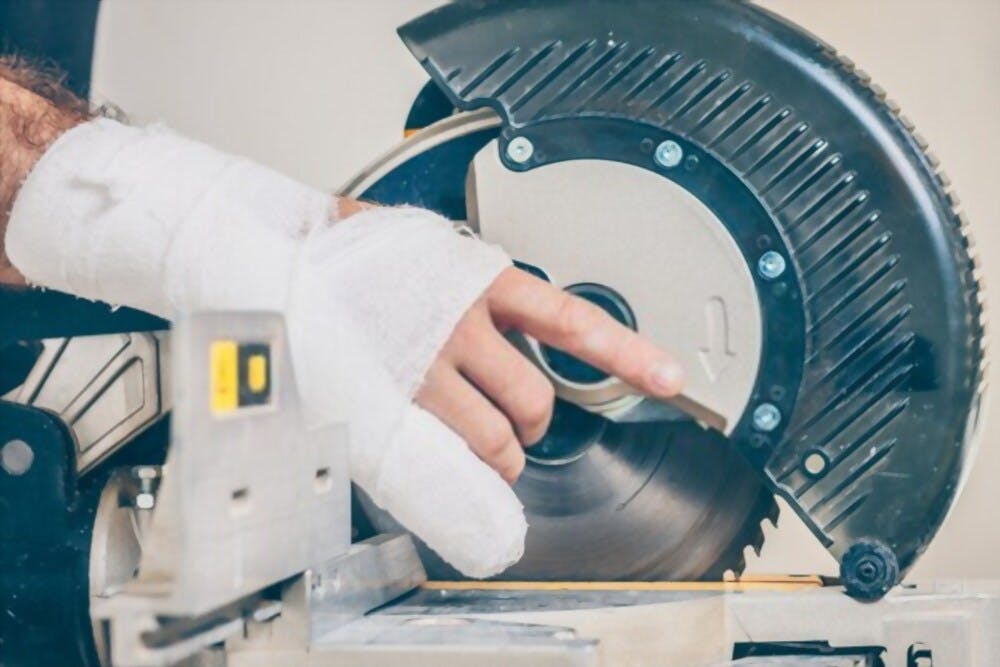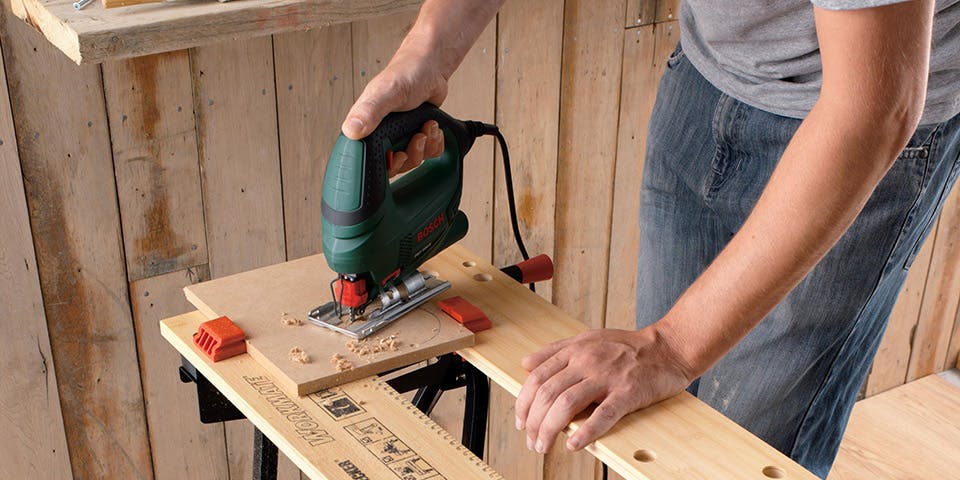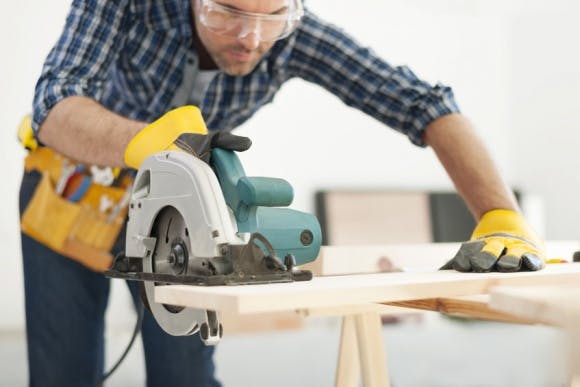Power Saw Injury Lawyer New York
Injury due to Power Saws not Equipped with a guard in New York State
Working with power saws and exposed blades is a dangerous activity that far too often results in serious injury. Serious injuries arise from the use of table saws, circular saws, miter saws, chop saws, wet saws and other cutting power tools such as angle grinders and reciprocating saws.

It is unfortunately common on job sites to have power saws have had the guards removed at some time prior to the time of accident. Our law firm has successfully represented numerous workers injured on NYC construction sites due to power saws not properly guarded. This category of construction accident requires a lawyer that knows the labor law and the applicable industrial code provisions and has a full understanding of construction site accidents and the legal relationships between the parties involved in the project.
Any worker in New York State who has sustained injury due to a power saw has a valid workers’ compensation claim.
In addition to a workers’ compensation claim, New York State has specific laws in place that provide a remedy to a worker who has sustained injury to an unguarded power saw (chain saws and circular brush saws excluded). This allows an injured worker to bring a regular lawsuit in addition to the workers’ compensation claim.
Section 241(6) of the New York State Labor Law imposes a non-delegable duty upon the general contractor and owner of qualified properties (excluded owners – owners of one or two family homes who contract for but do not direct or control the work) to insure that provisions within the New York State Industrial Code that have a specific requirement (not general) are complied with.
Section 241(6) provides as follows:
- All contractors and owners and their agents …, when constructing or demolishing buildings or doing any excavating in connection therewith, shall comply with the following requirements:
- All areas in which construction, excavation or demolition work is being performed shall be so constructed, shored, equipped, guarded, arranged, operated and conducted as to provide reasonable and adequate protection and safety to the persons employed therein or lawfully frequenting such places. The New York State Commissioner of Labor may make rules to carry into effect the provisions of this subdivision, and the owners and contractors and their agents for such work … shall comply therewith.
Any violation of a specific provision of the New York State Industrial Code imposes potential liability upon the general contractor and owner of qualified property.
The Industrial Code specifically requires the following:
§ 23-1.12 Guarding of power-driven saws and machinery.

- Every portable, power-driven, hand-operated saw which is not provided with a saw table, except chain saws and circular brush saws, shall be equipped with a fixed guard above the base plate which will completely protect the operator from contact with the saw blade when the saw is operating and with a movable self-adjusting guard below the base plate which will completely cover the saw blade to the depth of the teeth when such saw blade is removed from the cut.
- Every power-driven saw, other than a portable saw, shall be equipped with a guard that covers the saw blade to such an extent as will prevent contact with the teeth. In operation, such guard shall rise automatically by pressure from the material being cut or shall be so adjusted that as the saw cuts the material, the distance from the material to the underside of the guard does not exceed one-half inch. The exposed teeth of the saw blade beneath the table shall be effectively guarded. Every such saw shall be provided with a cut-off switch within easy reach of the operator without his leaving the operating position.
Exception: Any arm saw whose upper blade half is enclosed and which is provided with a front blocking bar or rod is not required to be guarded by the automatic rising pressure guard. - Every table circular saw used for ripping shall be provided with a spreader securely fastened in position and with an effective device to prevent material kickback.
§ 23-1.10 Power shut-off requirements for electrical and pneumatic hand tools.

Electric and pneumatic hand tools shall be disconnected from power sources and the pressure in hose lines shall be released before any adjustments or repairs are made except for the replacement of bits in electric drills. Before disconnecting any air hose, the air shall be shut off. Every electric and pneumatic hand tool shall be equipped with a cut-off switch within easy reach of the operator.
§ 23-1.8 Personal protective eye equipment.

Approved eye protection equipment suitable for the hazard involved shall be provided for and shall be used by all persons while employed in welding, burning or cutting operations or in chipping, cutting or grinding any material from which particles may fly, or while engaged in any other operation which may endanger the eyes.
§ 23-9.2 General requirements.
- Maintenance. All power-operated equipment shall be maintained in good repair and in proper operating condition at all times. Sufficient inspections of adequate frequency shall be made of such equipment to insure such maintenance. Upon discovery, any structural defect or unsafe condition in such equipment shall be corrected by necessary repairs or replacement. The servicing and repair of such equipment shall be performed by or under the supervision of designated persons. Any servicing or repairing of such equipment shall be performed only while such equipment is at rest.
- Operation. All power-operated equipment used in construction, demolition or excavation operations shall be operated only by trained, designated persons and all such equipment shall be operated in a safe manner at all times.
Any violation of the above provisions which is a cause of the accident, provides the basis for a third-party lawsuit. Even if the saw is the property of the injured workers’ employer, and even if the employer directed and supervised the work, this fact does not absolve the general contractor and owner of its obligation to insure compliance with the Industrial Code. In other words, active fault on the part of the owner of a qualified property and general contractor are not necessary to sustain a cause of action.
In a 241(6) Labor Law case the defendant is free to argue comparative fault on the part of the injured worker. It is therefore important that the injured worker refrain from providing significant statements after the accident, as such statements can be used to argue comparative fault later in a lawsuit.
Under most circumstances, the injured worker is provided with tools available and is instructed to get the job done. The law is framed with the understanding that the worker on a job site is often not in position on a job site to complain regarding safety measures.
Of course, there is no substitute to looking out for one’s own safety, but in the event of an accident involving a power saw, there is also no substitute for a detailed analysis of the facts of your accident with a lawyer that knows New York State Labor Law.
This category of the accident requires a lawyer that is fully versed in the procedural requirements of pleading a proper case, supporting the lawsuit with the proper expert, knowing the law and how fact specific the court is in the application of the law. Below are a few cases of interest on this topic, most of which have been the subject of appeal as often in this category of case there are motions for summary judgment made by the defendant to dismiss certain portions of the claim and sometimes motions made for summary judgment by the plaintiff seeking liability as a matter of law.
If you or someone you care for has been injured on a job site due to a saw related injury, please contact our law firm without hesitation for a free, no-obligation consultation.
Our firm is privileged to be of service to those who construct and build and improve the State of New York.
CASES OF INTEREST :
Vasquez v. Ridge Tool Pattern Co., 2020 NY Slip Op 32218(U) (June 30, 2020)
Floor installer injured by the router when it kicked back causing the bit to lacerate and sever his thumb. Plaintiff bought a Labor Law case based upon 241(6) violations predicated upon Industrial Code violations of Sections 23-1.12(a), © and (f) and 23-9.2(a), (b) and (d). The plaintiff also sued the manufacturer on a products liability theory of liability. The court significantly held that a router did not fall within the provisions that speak to a saw, but did find that Section 23-9.2(a) which requires all power-operated equipment to be maintained in good repair, as a viable predicate Industrial Code violation.
Vinciguerra v. Turner Const. Co., 2019 NY Slip Op 30814(U) (April 1, 2029)
Plaintiff used a demolition saw to cut an electrical conduit. The pipe bent and caused the saw to pinch and kick back thereby causing the plaintiff to fall down. Held Section 23-1.5©(3), which requires all safety devices, safeguards and equipment to sound and operable, is a specific provision and therefore supports the cause of action.
Woloszyn v. 834 Fifth Ave. Corp., 2018 NY Slip Op 32173(U) (September 5, 2018)
Plaintiff used a table saw to cut plywood. The plywood jumped and pulled his arm to the blade. The court granted summary judgment to the plaintiff as the court found a violation as a matter of law on Section 23-1.12©(2), which requires that the blade be equipped with a guard.
Williams v. River Place II, LLC, 145 A.D.3d 589 (2016)
Plaintiff injured by a power saw that had missing teeth on the blade. Plaintiff sued for the violation of Section 241(6) based upon a violation of Section 23-1.12©(1) and (3), which requires “all safety devices, safeguards and equipment in use shall be kept sound and operable, and shall be immediately repaired or restored or immediately removed from the job site if damaged.” Court held that there is a question of fact as to the application of this provision for the jury on a violation and the cause of the accident.
Sheng Hai Tong v. K and K 7619, Inc, 114 A.D.3d 887 (2016)
Plaintiff was cutting tile with a makeshift table saw by affixing a circular saw upside down to the bottom of a table. The safety guard was under the table while the blade was on top. The plaintiff claimed a violation of Section 23-1.23©(2), which requires “every power driven saw, other than a portable saw, … be equipped with a guard…”. The trial court dismissed the case and the Second Department reversed, concluding that the way the saw is used should be considered and not just the type of saw involved. Here a portable saw was being used as a table saw, and therefore should be considered a table saw under the facts of this case.
Osborn v. 56 Leonard LLC, 138 A.D.3d 624 (2016)
A worker injured by an unguarded power saw blade in New Jersey for fabrication of material to be used on a New York construction site, not entitled to the benefits of New York State Labor Law (Section 241(6)), as the accident itself must take place within New York.
Scoz v. J&Y Elec. & Intercom Co. Inc., 137 A.D.3d 535 (2016)
Plaintiff who was an independent contractor who intentionally used the wrong tool for the job and jury-rigged the saw in a manner that would render any guard ineffectual, was held to be the sole proximate cause of the accident as a matter of law despite the claimed industrial code violations.
This case seems to stand for the proposition that an independent contractor who as opposed to an employee who is provided with a tool may be held to a higher standard of care in the application of Section 241(6) violation case.
Becerra v. Promenade Apts. Inc., 126 A.D.3d 557 (2015) (First Department)
Plaintiff as a demolition worker injured his hand while using an unguarded angle grinder. The trial court dismissed the case as a matter of law concluding that Section 23-1.5© was too general to be relied upon in a 241(6) violation case. The appellate division reverses and reinstates the case, concluding that it does, and that the same section encompasses grinders, even though grinders are not specifically enumerated in Section 23-1.12©(1) (which is limited to saws).
Ortega-Estrada v. 215-219 W. 145th St., LLC, 118 A.D.3d 614 (2014) First Department)
Plaintiff awarded summary judgment as to liability after injured using a table saw without a guard or spreader based upon a violation of Section 23-1.12©(2)(3). The plaintiff was the sole witness to his accident. The defendant failed to present evidence of culpable conduct on the part of the plaintiff.
This case stands for the proposition that the plaintiff may be entitled to judgment as a matter of law on unguarded saw blade accidents where the plaintiff can not be considered to have been culpable in the cause of the accident.
Kruk v. City of New York, 112 A.D.3d 518 (2013) (First Department)
Plaintiff injured by power saw that was in fact equipped with a guard, has case dismissed as a matter of law. Plaintiff’s only argument was that he should have been provided with a table saw. Even though this may be the best practice, there is no specific provision in the Industrial Code that requires this practice.
Keneally v. 400 Fifth Realty LLC, 110 A.D.3d 624 (2013) (First Department)
Plaintiff injured by power saw with a moveable self-adjusting guard which allegedly failed to cover the saw blade to the depth of the teeth when the saw blade was removed from the cut. This observation was supported by a witness and an expert. Court held that Section 23-1.12©(1) supports a cause of action.
Murillo v. Porteus, 108 A.D.3d 753 (2013) (Second Department)
Defendant home owner moved to dismiss a case brought against him by a worker injured by a table saw that was not properly guarded. Court held that the common law negligence case based upon violation of Section 200 of the labor law is viable as the defendant homeowner was unable to prove that he did not have notice of the defective condition as the table saw was owned by him and at the house at the time of the accident. Furthermore, the Section 241(6) case is also viable as there is a question of fact as to whether the homeowner directed and controlled the work and therefore is outside the single family exception, which provides legal protection to owners of single family homes. There is also a question of fact if the property is a rental property and therefore commercial in nature and outside the single family exception protection.
Noetzell v. Park Avenue Hall Housing Development Fund Corporation, 271 A.D.2d 231 (2000) (First Department)
Plaintiff severed thumb while using power saw which was claimed to have lacked a handle locked the blade into position, lacked a guard and lacked a brake that activated upon removing finger from trigger is allowed to proceed even though attorney for plaintiff failed to industrial code provisions which supported the cause of action in the complaint and initial bill of particulars.
Even with best efforts employed to prevent construction accidents, they do and will happen. If involved in a construction accident, contact us. While we cannot necessarily prevent accidents from happening, when they do, we will do everything we can to get you the most amount of compensation possible. The Law Offices of JOEL J. TURNEY, LLC, knows this area of law and we will work tirelessly to achieve the best results possible for construction workers and tradesmen injured in NYC and New York State construction site accidents.
What is My Power Saw Injury Case Worth?
Contact The Law Office of Joel J. Turney, LLC today and find out what your case is worth. Call (212) 840-7000 or submit this form for a FREE case evaluation.

